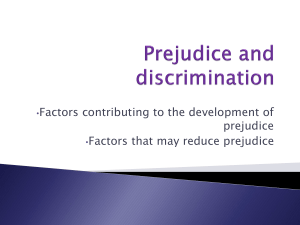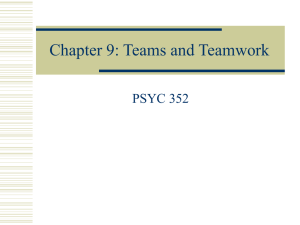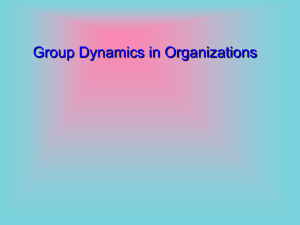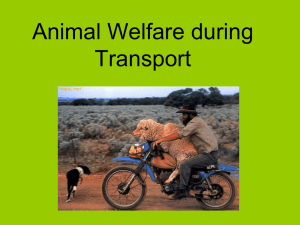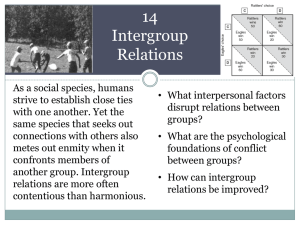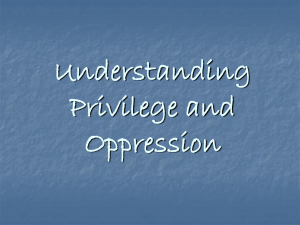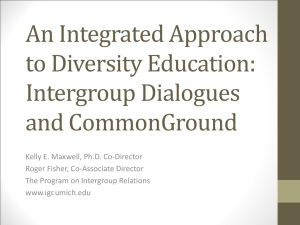IIIA.Negative Peace - Society for the Study of Peace, Conflict
advertisement
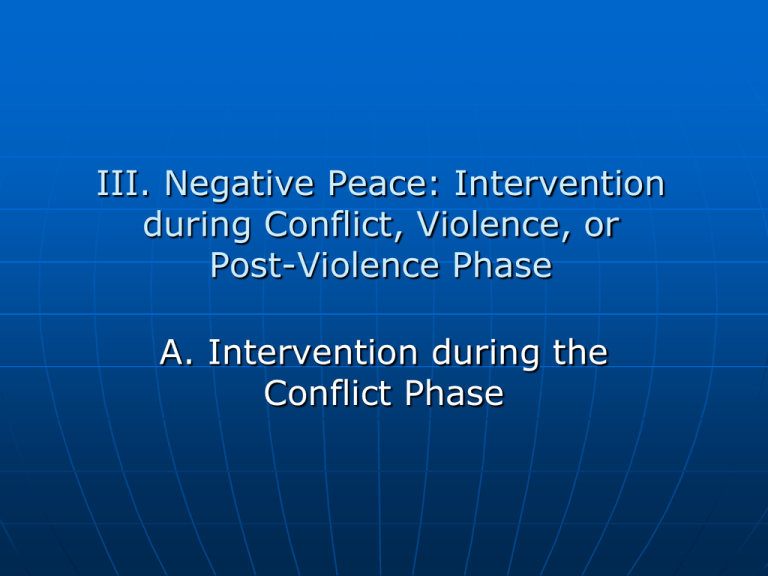
III. Negative Peace: Intervention during Conflict, Violence, or Post-Violence Phase A. Intervention during the Conflict Phase Conflict Resolution: Theoretical and Practical Issues Definitions of Conflict • perceived differences in interests, views, or goals (Deutsch, 1973); • opposing preferences (Carnevale & Pruitt, 1992); • a belief that the parties’ current aspirations cannot be achieved simultaneously (Rubin, Pruitt, & Kim, 1994); Sanson & Bretherton (2001) Causes of Conflicts Limited Resources (time, money, property) Unmet Basic Needs (security, identity, material necessities, self-determination) Clashing Values (freedom versus equality) Beliefs (chosen people) Ideologies (capitalism versus communism; religious extremism) Conflict and Violence Conflict is primarily about human cognition Violence primarily involves behavior Conflicts are inevitable Violence is not inevitable Conflicts can be constructive or destructive Violence is destructive Conflict Resolution: Theoretical and Practical Issues Principles of Conflict Resolution • conflict resolution is a cooperative endeavor, rather than competitive) • solutions sought are integrative ones, meeting the interests and needs of all • foundation is an understanding of all parties’ interests, versus power or rights-based approaches • both the process and its outcome are nonviolent Sanson & Bretherton (2001) Conflict Resolution: Theoretical and Practical Issues From Principles to Practice • Build cooperative attitude (not competitive) • Use active listening for interests • Listen also for feelings • Move from positions to an analysis of interests and needs of each party • Communicate interests and needs • Strive for Integrative Solutions, expanding the pie • If serious difficulties in negotiating arise, formulate BATNA Sanson & Bretherton (2001) Interest Based Approach Position Interests/Concerns Needs & Values Mutual Empathy Conflict Resolution: An Opportunity for Joint Problem Solving & Relationship Building High Competing Contending Assertiveness Collaborative Problem Solving Compromise (concern for self) Low Avoiding Low Accommodating Cooperativeness (concern for the relationship) High Conflict Resolution: Theoretical and Practical Issues Lewicki et al., (1992) identified 44 major models of conflict, negotiation, and third-party processes Some Models and Perspectives • Principled Negotiation Model (Fisher & Ury, 1996) • Creative Problem-Solving Model (Pruitt & Rubin, 1986) • Problem-Solving Conflict Resolution Model (Burton, 1987) • Problem-Solving Workshops (Kelman, 1997) Sanson & Bretherton (2001) Conflict Resolution: Theoretical and Practical Issues Principled Negotiation Model (Fisher & Ury, 1996) • Separate the people from the problem • Focus on interests • Invent options for mutual gain • Insist on objective criteria to judge solutions Creative Problem-Solving Model (Pruitt & Rubin, 1986) • Set reasonably high aspirations for gains • Pursue with firmness and commitment and flexibility Sanson & Bretherton (2001) Conflict Resolution Problem-Solving CR Model (Burton, 1987) • Analyze parties and issues • Facilitate interaction and exploration of positions • When there is an agreed definition of the problem, explore possible options • Groups meet in private and “controlled communication” takes place (correcting misperceptions, improving accuracy of assessment) Problem-Solving Workshop (Kelman, 1997) • Addresses inter-ethnic conflict, emphasizing empathy, insight, creative problem solving and learning • Involves politically interested but unofficial representatives of the conflicted parties Sanson & Bretherton (2001) Responses to Conflict and Some Psychological Consequences a. Withdrawing (self-destructive behavior) b b. Dominating (aggression) c. Submitting (depression) a b d a d. Engaging (healthy) e. Vascillating (anxiety) c c Levels of Conflict Intrapersonal or Intrapsychic (psychotherapist?) Interpersonal (marriage counselor?) intragroup (leadership?) intergroup (diplomacy?) Inter and multi-state (world government?) Conflict Resolution: Theoretical and Practical Issues Cultural Limitations (East meets West) • Directness • Avoidance • Conflict as constructive • Harmony as a value • Individualistic • Nonhierarchical Prejudice Reduction: What Works? Review: broad scope, methodological focus (internal & external validity), & practical and theoretical recommendations Special Emphasis: on causal pathway from some intervention to a reduced level of prejudice (i.e., use of random assignment) Paluck & Green, 2009, ARP Prejudice Reduction: What Works? Method: 985 published and unpublished reports, 72% published. Methods, interventions, and dependent variables diverse: meta-analysis potentially meaningless Paluck & Green, 2009, ARP Prejudice Reduction: What Works? Structure of Review: 1. Nonexperimental prejudice-reduction field research. 2. Prejudice reduction in the laboratory. 3. Field experiments in order to assess the correspondence between 1 & 2. Paluck & Green, 2009, ARP Nonexperimental Field Research Outcomes can be explained by a combination of “intervention, random chance, and unmeasured preexisting differences between comparison groups (p. 343).” “For scientists who understand prejudice as a pandemic of the same magnitude as that of AIDS or cancer, a reliance on nonexperimental methods seems justifiable only as a short-run approach en route to experimental testing (p. 343).” “...majority of prejudice-reduction interventions (77%) are evaluated solely with nonexperimental methods, when they are evaluated at all (p. 343).” Paluck & Green, 2009, ARP Nonexperimental Field Research 1. Qualitative Studies 2. Cross-Sectional Studies 3. Quasi-Experimental Panel Studies 4. Near-Random Assignment Paluck & Green, 2009, ARP Nonexperimental Field Research Qualitative Studies: Gather narrative (textual, nonquantified) data and typically observe rather than manipulate variables. • Useful in generating hypotheses • Cannot reliably assess impact of a program • Can augment and further explore experimental measurement of outcomes Paluck & Green, 2009, ARP Nonexperimental Field Research Cross-Sectional Studies: A design in which two or more naturally existing (i.e., not randomly assigned) groups are assessed and compared at a single time point. • Conflate participants’ predispositions with program impact • Cannot establish causality (even with statistical controls) because of unmeasured differences between treatment and control groups. Paluck & Green, 2009, ARP Nonexperimental Field Research Quasi-Experimental Panel Studies: Experiments with treatment and placebo or no-treatment conditions in which the units are not randomly assigned to conditions. • Social Justice Educational Program at U of MI. (Gurin et al., 1999) Pretest: matching on gender, race/ethnicity, etc. Four years and four post-tests White students saw more commonality in values with various groups of color than white control students • Internal validity remains questionable Paluck & Green, 2009, ARP Nonexperimental Field Research Near-Random Assignment (e.g., waiting list design) • Corporate Diversity Training (Hanover & Cellar, 1998) • Assigned white managers to diversity training, using a phased-in mandatory training policy • Those with training vs. not: (a) rated diversity practices as important, and (b) more likely to discourage prejudiced comments Causality can be inferred; unfortunately, all measures were self-report. Paluck & Green, 2009, ARP Laboratory Experimental Research 1. Intergroup Approaches Contact Hypothesis Social Identity and Categorization Theories 2. Individual Approaches Instruction Expert Opinion and Norm Information Manipulating Accountability Consciousness Raising Targeting Emotions Targeting Value Consistency & Self-Worth Paluck & Green, 2009, ARP Laboratory Experimental Research: Intergroup Approaches Contact Hypothesis • Interaction between two groups should reduce prejudice under conditions of Equal status; shared goals authority sanction, and absence of competition (Pettigrew & Tropp, 2006) • Cook’s (1971, 1978) classic railroad studies Assignment of white young adults to work on a railroad company management task with two “co-workers” (one black and one white confederate) Experimental group exhibited higher ratings of black coworker on attractability, likeability, and competence One month follow up: less racial prejudice that controls. Paluck & Green, 2009, ARP Laboratory Experimental Research: Intergroup Approaches Social Identity and Categorization Theories Minimal Group Paradigm (MGP) • Decategorization Approach (Individual) • Recategorization (Superordinate) • Crossed Categorization (Shared 3rd Group) • Integrative Models (Crossed & Superordinate) Most Empirical Support: Crossed & Integrative • Consistent with multicultural policies that emphasize ethnic diversity under a common national identity Paluck & Green, 2009, ARP Laboratory Experimental Research 1. Intergroup Approaches Contact Hypothesis Social Identity and Categorization Theories 2. Individual Approaches Instruction Expert Opinion and Norm Information Manipulating Accountability Consciousness Raising Targeting Emotions Targeting Value Consistency & Self-Worth Paluck & Green, 2009, ARP Laboratory Experimental Research: Individual Approaches Instruction (addresses ignorance) • Modest success: attitude change, friendliness, diminished stereotypes Expert Opinion and Norm Information • Modest success: attitude change when people are told, for example, experts believe personality is malleable (Levy et al., 1998) or stereotyping is not the norm for peers (Stangor et al., 2001) Paluck & Green, 2009, ARP Laboratory Experimental Research: Individual Approaches Manipulating Accountability • MGP: allocation to out-group changes when asked to justify (Dobbs & Crano, 2001) Consciousness-raising • Implicit Attitudes Test (IAT): classification speed and strength of association • IAT changes though (a) memory of past discrimination – guilt! (Son Hing et al., 2002); (b) pairing stigmatized groups with positive images (Dasgupta & Greenwald, 2001) Paluck & Green, 2009, ARP Laboratory Experimental Research: Individual Approaches Targeting Emotions • Perspective Taking and Empathic Inductions (Batson, 1991) enjoy some success. Targeting Value Consistency • Cognitive Dissonance (Festinger, 1957): Agreeing to write public statements favoring pro-black policies produces attitude changes toward anti-black policies (Eisenstadt et al., 2003) • Self-Affirmation Theory (Steele, 1998): Some evidence for reduction in derogation of others when self-worth affirmed Paluck & Green, 2009, ARP Lessons for the Real World from Laboratory Experiments Internal Validity (causal impact) can be tested External Validity often questionable: Limited by Interventions: usually brief, subtle, and at micro level Environment: artificial Population: North American college students Prejudices: MGP shorn of context; hard-core prejudices not examined Measures: Low stake behaviors (e.g., tokens), indirect (e.g., linguistic bias), IAP-behavior link questionable Theories: Lab-generated echo chamber Paluck & Green, 2009, ARP Experimental Research Conducted in the Field Supplemental Table 1 provides summary Total of 71 studies (minus cooperative learning) 56% lasted one day or less 84% with students or school personnel Only 11 studies involve measures of behavior Power problem: half have samples n<100 Paluck & Green, 2009, ARP Experimental Research Conducted in the Field 1. Cooperative Learning 2. Entertainment • Reading • Media 3. Discussion and Peer Influence 4. Instruction Paluck & Green, 2009, ARP Experimentation in the Field: Cooperative Learning Typical Outcomes of “Jigsaw classroom” (Aronson et al., 1978): increases in interpersonal attraction, perspective taking, social support, and constructive conflict management Generalization: seldom tested Paluck & Green, 2009, ARP Experimentation in the Field: Entertainment Change processes: Narrative persuasion & extended contact rather than informational approach • Narrative persuasion theory: emphasizes perspective taking, empathy, communicating social norms • Extended contact hypothesis: vicarious experience of cross-group friendships Paluck & Green, 2009, ARP Experimentation in the Field: Entertainment Reading: 11 of 17 studies yielded positive outcomes, mostly self-reported attitude change - e.g., friendship and shared adventures with a disabled child (Cameron & Rutland, 2006) Media: Year-long radio soap opera, a fictional story about two Rwandan communities. N=600 citizens, prisoners & genocide survivors. Affected perception of social norms and behavior re intermarriage, open dissent, cooperation & trauma healing, but did not change personal beliefs (Paluck, 208; Paluck & Green, 2008). Paluck & Green, 2009, ARP Experimentation in the Field: Entertainment Instruction: Jewish students and perspective taking (i.e., write essay from Palestinian point of view), resulting in more sympathy to damages and to power asymmetry (Lustig, 2003) Other (less frequently used) approaches • Contact (e.g., Outward Bound camping expedition) • Social Identity & Categorization (e.g., green circle community) Paluck & Green, 2009, ARP Some Green Circle Concepts 1. The Green Circle represents "your world of people -- the people you care about!" 2. Your Green Circle begins with YOU -- when you were a baby. 3. The circle must grow in order to include family and friends. 4. It feels good to be INSIDE the Green Circle. 5. It feels bad to be OUT of the Green Circle. 6. People who are excluded from the Green Circle feel the same way I felt when I was outside the Green Circle. 7. Each child must take POSITIVE action in order to include someone in his/her circle. 8. People of different sizes and shapes can be in the circle. 9. People of all colors can be in the circle. 10. People of all religions can be in the circle. 11. Physically challenged (handicapped) people can be in the circle. 12. All people belong to the human family. 13. Our circle grows when our hearts are loving. 14. YOU must decide who is going to be in your circle. Experimentation in the Field: Entertainment Instruction: Jewish students and perspective taking (i.e., write essay from Palestinian point of view), resulting in more sympathy to damages and to power asymmetry (Lustig, 2003) Other (less frequently used) approaches • Contact (e.g., Outward Bound camping expedition) • Social Identity & Categorization (e.g., green circle community) • Value Consistency & Self-worth (e.g., Rokeach value confrontation) Paluck & Green, 2009, ARP Conclusions Some Lessons from Field Experiments • Dearth of evidence for most prejudice-reduction programs • Cooperative learning breaks down barriers between students • Extended contact can reduce outgroup hostility • Narratives can communicate norms, encourage empathy & perspective taking • Recommendation: Use field as lab to generate theory Paluck & Green, 2009, ARP Summary Spending on diversity training in US is estimated at US$8 billion annually (Hansen, 2003) Yet, key questions remain unanswered such as: Do diversity training workshops encourage empathy and break down stereotypes; or do they elicit reactance and reinforce stereotypes? Due to weaknesses in internal and especially external validity, we don’t know whether, when, and why interventions reduce prejudice in the world. Nonexperimental research can offer guidance on the how question but not what works and why. More theoretically grounded randomized field based studies could begin to answer the whether, when and why questions Paluck & Green, 2009, ARP Intergroup Contact and the Improvement of Intergroup Relations Tausch, N., Kenworthy, J., & Hewstone, M. (2001). Intergroup contact and the improvement of intergroup relation. In M. Fitzduff & C. Stout (Eds.), The psychology of resolving global conflicts: From war to peace, Vol. 2 (pp. 67-107). Westport, CT: Praeger Security International. Intergroup Contact and the Improvement of Intergroup Relations 1. Dependent Variables 2. Moderating Variables 3. Mediating Mechanisms 4. Guidelines for Applications Tausch et al., 2006 Intergroup Contact: Dependent Variables Cognitive variables Selective Attention Attributions of Behavior Perception Stereotype Biases Seeking ExpectancyConfirming Evidence Elaboration of Events Memory of Events Tausch et al., 2006 Intergroup Contact: Dependent Variables Some Cognitive Consequences • Decrease in negative stereotypes • Increase in outgroup variability • Decrease in infrahumanization (attributing uniquely human characteristics to one’s ingroup) Tausch et al., 2006 Intergroup Contact: Dependent Variables Some Affective Consequences • Note: Affective variables predict intergroup behavior better than stereotypes (Talaska, Fiske, & Chaiken, 2003) • Specific emotions, can have specific behavioral consequences (Smith, 1999) Fear --------- Flight Anger ------- Fight Disgust ----- Avoid • Forgiveness - also associated with guilt, perspective taking and trust (Hewstone, Cairns, Voci, Hamberger, & Niens, U. (2006) Tausch et al., 2006 Intergroup Contact: Moderator Variables Allport (1954): Optimal conditions include equal status, cooperation toward common goal, & institutional support Are the conditions necessary? Sufficient? Pettigrew & Tropp (2006) meta-analysis of over 500 studies found a robust highly significant negative effect of contact on prejudice, even when contact did not meet ‘optimal conditions’ Hence, conditions are not necessary but enhance or facilitate the basic contact effect. Quality of interactions matter. Tausch et al., 2006 Intergroup Contact: Moderator Variables Quality Matters: • Negative contact effects 5% of the time; negative factors (obstacles) may include anxiety, threat, and stereotype confirmation (Pettigrew & Tropp, 2006). • Other obstacles: competition or participation is involuntary, frustrating, tension laden, or threatens the status of one of the groups (Amir, 1969, 1976). Tausch et al., 2006 Intergroup Contact: Eleven Moderator Variables that Facilitate 1. Equal Status • Allport emphasized equal status with respect to task • Boosting “expectations” of the performance of minority members may be helpful (Cohen & Roper, 1972) • However, if large status differences exist in society, generalization of effects may be a problem 2. Cooperation • Positive-sum expectations important • Importance of cooperative learning well established • However, failure on a cooperative task can increase intergroup bias (Worchel et al., 1977) Tausch et al., 2006 Intergroup Contact: Eleven Moderator Variables that Facilitate 3. Institutional Support • Demonstrated in many field-based studies 4. Group membership should be kept salient in contact situation for generalization to occur • Otherwise, subtyping can be a problem 5. Cross-group friendships • Personalized friendships result in group categories being deemphasized (Pettigrew, 1997) • Prejudice reduction: Outgroup friendship > contact; better yet, friendship x contact. (Pettigrew & Tropp, 2006) Tausch et al., 2006 Intergroup Contact: Eleven Moderator Variables that Facilitate 6. Extended contact: merely knowing an in-group members has a close relationship with an outgroup member can lead to more pos intergroup attitudes • Mediating mechanism may be intergroup anxiety (Stephen & Stephan, 1985) or perceived ingroup norms (Tausch et al., 2006) • Works for majority and minority members (Wright et al., 1997) Tausch et al., 2006 Intergroup Contact: Eleven Moderator Variables that Facilitate 7. Person Factors • Can’t manipulate but may be useful for selection of participants • Higher levels of education, socioeconomic status, and younger individuals (Stephen, 1987) • Political affiliation? • High self-esteem, low authoritarianism, Protestant work ethic, high competence in task-relevant skills (Stephen, 1987) 8. Choice • Effect sizes larger when participants have little choice in participating (Pettigrew & Tropp, 2006) Tausch et al., 2006 Intergroup Contact: Eleven Moderator Variables that Facilitate 9. Number of Participants • In small groups, balanced ratios of in-group and outgroup members beneficial (Stephan, 1987) 10. Group Status • Significant effects weaker for minority group members (Pettigrew & Tropp, 2006) 11. Macro Factors • Normative support (Pettigrew, 1998), institutional leadership, political discourse, media framing (Taylor, 2000) Tausch et al., 2006 Intergroup Contact: Mediating Mechanisms Cognitive mechanisms • Information (addressing ignorance) mediates only about 1 percent of the reduction in prejudice (Pettigrew & Tropp, 2006)! • Reducing the Salience of Social Categories Decategorization (Individualized) Recategorization (Superordinate) • Increasing Salience of Social Categories Categorization (Inter-Group) • Integrated (complementary) Approaches D & C; R & C (Dual Social Identities); D-> C-> R (Threestage longitudinal model) Tausch et al., 2006 Intergroup Contact: Cognitive Mediating Mechanisms Decategorization: focus on individual vs. category based information, can affect reward allocation • Problems: may be restricted to majority group members (Bettencourt et al., 1997); also subtyping; generalization to intergroup relations. Recategorization (Common In-group Identity Model): from us and them to we, i.e., superordinate identity. Typical manipulations: Seating arrangements; shirt colors • Problems: Deep divisions in the real world; generalization to intergroup relations. Tausch et al., 2006 Intergroup Contact: Cognitive Mediating Mechanisms Categorization Approach (Hewstone & Brown, 1986) 1. Contact is intergroup not interpersonal encounter 2. Complementary roles toward common goal (positive interdependence) • Problems: intergroup anxiety; greater ingroup bias; reinforcement of stereotypes; generalization of negative information Tausch et al., 2006 Intergroup Contact: Cognitive Mediating Mechanisms Integration of Theoretical Models • Decategorization & Categorization: emphasizes both personalization and typicality producing generalized positive contact effects. • Recategorization and Categorization: A dual identity approach, generally producing positive outcomes perhaps especially for minority groups ... Consistent with pluralistic integration of ethnic minorities within a society • Decategorization -> Categorization -> Recategorization: The first step is meant to prevent anxiety; second to generalize positive attitudes from individiual to group; third stage may maximize reduction of prejudice (Pettigrew, 1998) Tausch et al., 2006 Intergroup Contact: Affective Mediating Mechanisms Affective processes more predictive of behavior than cognitive variables (e.g., Talaska et al., 2003) Positive and negative affect can function independently (Cacioppo & Bernston, 2001); hence, both should be targeted Tausch et al., 2006 Intergroup Contact: Affective Mediating Mechanisms Negative Affect: Anxiety • Pettigrew & Tropp (2006) meta-analytic findings suggest ~21% of the contact effect on reduced prejudice is mediated by reduced anxiety! • The effects of cross-group friendships (both direct and extended) on the reduction of prejudice and the increase in perceived outgroup variability is mediated by anxiety reduction (Wright et al., 1997) Tausch et al., 2006 Intergroup Contact: Affective Mediating Mechanisms Negative Affect: Threat • Perceptions of threats to the in-group can be real or symbolic (e.g., threats to in-group’s values, beliefs, worldview, language, religion, ideology, morality) • Growing evidence that symbolic threats are powerful mediators of prejudice Tausch et al., 2006 Intergroup Contact: Affective Mediating Mechanisms Positive Affect: • Empathy reduced white prejudice toward blacks (cf. Finlay & Stephan, 2000) partially mediated relationship between contact and attitudes between Catholics and Protestants in N. Ireland (Tam et al., 2003) • Perspective Taking Can reduce both explicit and implicit stereotyping (Galinsky & Moskowitz) mediates the relationship between contact and intergroup bias i.e., prejudice, trust, and forgiveness (Craig et al., 2002) Tausch et al., 2006 Applying Intergroup Contact Research in the Field: Limitations Direction of Causality: Contact hypothesis is framed as a longitudinal effect, most studies are cross-sectional Lack of Behavioral Measures Changes in cognition and feelings do not imply changes in behavior Unit of Analysis Problem The problem of causality has been addressed many ways (e.g., statistical control, longitudinal & experimental designs) and generally suggest causality is bidirectional Changes in individual attitudes do not imply changes in societal norms Ethical Concerns Changes in positive affect do not imply changes in power relations Tausch et al., 2006 Applying Intergroup Contact Theory in the Field: Applications 1. Equal status (Altering expectations, if necessary, re task competence) 2. Cooperation toward common goal 3. High profile representatives (e.g., politicians, community leaders, etc.) 4. Personalized contact (anxiety reduction?) 5. Typicality and explicit linkages between participants and group 6. Employ extended contact (exploiting public role models who have close relationship with outgroup members Tausch et al., 2006 Applying Intergroup Contact Theory in the Field: Applications 7. Contact should be repeated and prolonged (consolidating friendships and changed attitudes) 8. Rigorous evaluation of intervention programs, including actual levels of interaction (cf. Moaz, 2002); longitudinal or experimental designs, behavioral measures; 9. Societal indicators of social change (policy, norms, public opinion) should be assessed 10.Psychological mechanisms should be impacted: empathy, perspective taking, anxiety and threat reduction. Tausch et al., 2006

